Holmes Institute HI5017 Managerial Accounting Assignment Analysis
VerifiedAdded on 2022/10/10
|13
|3504
|14
Homework Assignment
AI Summary
This assignment critically evaluates the purpose and practical use of management accounting systems (MAS) in contemporary organizations, focusing on their relevance to real-life decision-making and business goals. The analysis centers on a case study of a multinational manufacturing company and compares its findings with another journal article, exploring techniques like Balanced Scorecard (BSC), Just in Time (JIT), and Total Quality Management (TQM). The assignment investigates how MAS supports effective cost management, strategic alignment, and competitive advantage within a dynamic business environment. It highlights the importance of adapting MAS to changing organizational needs, emphasizing the need for dynamic and modified systems. Furthermore, the document emphasizes the application of MAS to enhance productivity, improve manufacturing processes, and inform pricing strategies. The conclusion underscores the essential role of MAS in navigating today's competitive and uncertain business landscapes.

Running head: INDIVIDUAL ASSIGNMENT 1
Individual Assignment
Name
Institution
Professor
Course
Date
Individual Assignment
Name
Institution
Professor
Course
Date
Paraphrase This Document
Need a fresh take? Get an instant paraphrase of this document with our AI Paraphraser
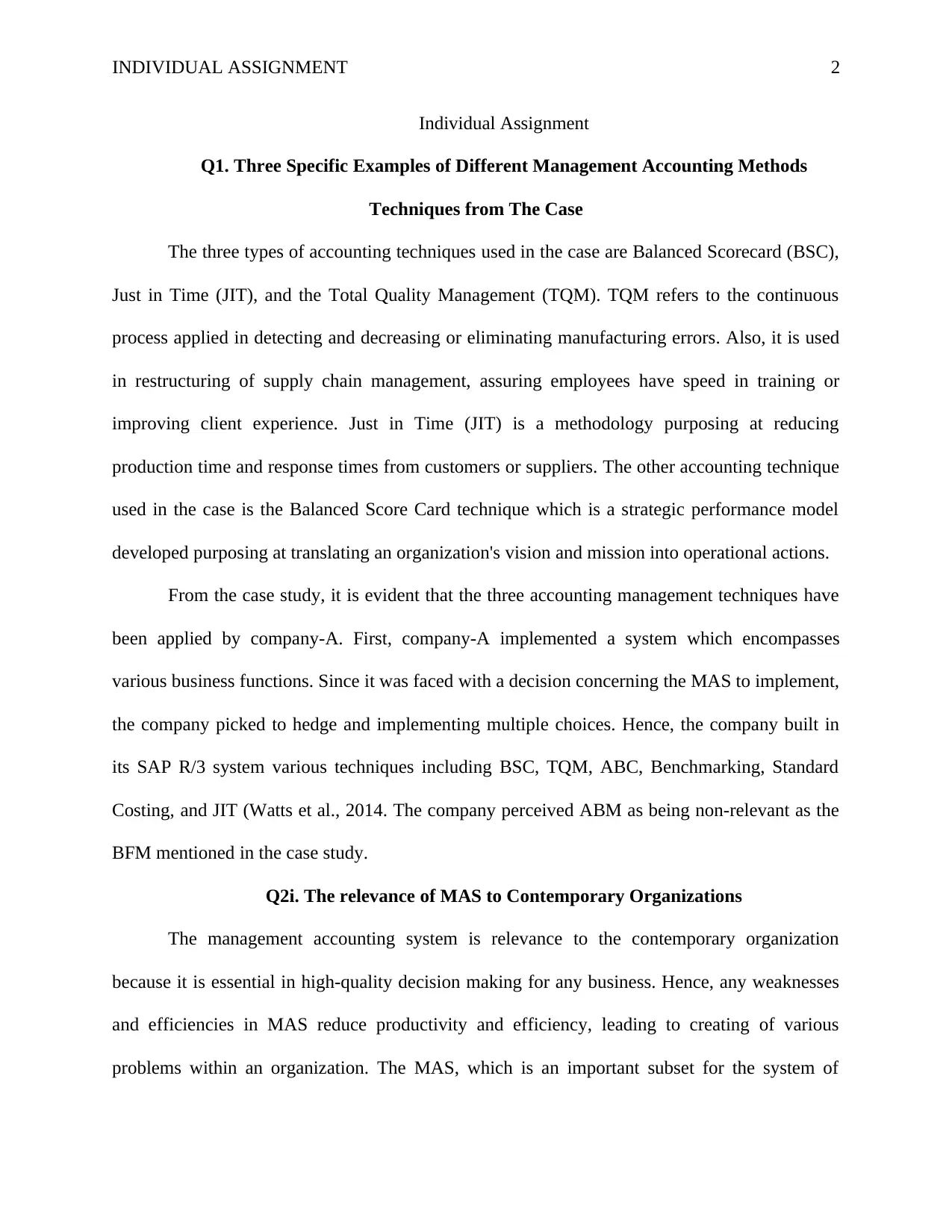
INDIVIDUAL ASSIGNMENT 2
Individual Assignment
Q1. Three Specific Examples of Different Management Accounting Methods
Techniques from The Case
The three types of accounting techniques used in the case are Balanced Scorecard (BSC),
Just in Time (JIT), and the Total Quality Management (TQM). TQM refers to the continuous
process applied in detecting and decreasing or eliminating manufacturing errors. Also, it is used
in restructuring of supply chain management, assuring employees have speed in training or
improving client experience. Just in Time (JIT) is a methodology purposing at reducing
production time and response times from customers or suppliers. The other accounting technique
used in the case is the Balanced Score Card technique which is a strategic performance model
developed purposing at translating an organization's vision and mission into operational actions.
From the case study, it is evident that the three accounting management techniques have
been applied by company-A. First, company-A implemented a system which encompasses
various business functions. Since it was faced with a decision concerning the MAS to implement,
the company picked to hedge and implementing multiple choices. Hence, the company built in
its SAP R/3 system various techniques including BSC, TQM, ABC, Benchmarking, Standard
Costing, and JIT (Watts et al., 2014. The company perceived ABM as being non-relevant as the
BFM mentioned in the case study.
Q2i. The relevance of MAS to Contemporary Organizations
The management accounting system is relevance to the contemporary organization
because it is essential in high-quality decision making for any business. Hence, any weaknesses
and efficiencies in MAS reduce productivity and efficiency, leading to creating of various
problems within an organization. The MAS, which is an important subset for the system of
Individual Assignment
Q1. Three Specific Examples of Different Management Accounting Methods
Techniques from The Case
The three types of accounting techniques used in the case are Balanced Scorecard (BSC),
Just in Time (JIT), and the Total Quality Management (TQM). TQM refers to the continuous
process applied in detecting and decreasing or eliminating manufacturing errors. Also, it is used
in restructuring of supply chain management, assuring employees have speed in training or
improving client experience. Just in Time (JIT) is a methodology purposing at reducing
production time and response times from customers or suppliers. The other accounting technique
used in the case is the Balanced Score Card technique which is a strategic performance model
developed purposing at translating an organization's vision and mission into operational actions.
From the case study, it is evident that the three accounting management techniques have
been applied by company-A. First, company-A implemented a system which encompasses
various business functions. Since it was faced with a decision concerning the MAS to implement,
the company picked to hedge and implementing multiple choices. Hence, the company built in
its SAP R/3 system various techniques including BSC, TQM, ABC, Benchmarking, Standard
Costing, and JIT (Watts et al., 2014. The company perceived ABM as being non-relevant as the
BFM mentioned in the case study.
Q2i. The relevance of MAS to Contemporary Organizations
The management accounting system is relevance to the contemporary organization
because it is essential in high-quality decision making for any business. Hence, any weaknesses
and efficiencies in MAS reduce productivity and efficiency, leading to creating of various
problems within an organization. The MAS, which is an important subset for the system of

INDIVIDUAL ASSIGNMENT 3
financial or non-financial information offers different information types for users, specifically
managers of organizations. Also, management accounting systems seeks at assigning a device
where the assignment is done with administration permission and selecting of operational goals.
The selected objectives are then distributed across the organization.
The contemporary organizations encounter the phenomenon of conflict among the
various constituents’ portions of the whole system like the subsystems and subsets. The conflict
occurs due to factors like the differences in cognition and perception, norms, ideals, goals,
values, and standards of the managers. Consequently, the dependence on regular organization
parts, uncertainties in responsibilities and roles are some features which should be managed or
resolved through managers tactfulness.
From the case study, it is clear that contemporary management tools assist organizations
in achieving effective cost managing accounting process for allocating resources to actions. After
that, there is the allocation of events to cost items via assigned fundamental relations established
on volume or non-volume associated drivers. For instance, it is known that ABC results in
various benefits by eliminating misrepresentations from the traditional price accounting system
and correct cost info for excellent decision making. Also, ABC leads to more effectual operating
act and strategic decision making. Although the ABC theoretical analysis of ABC seems
superior, its implementation on various businesses shows mixed results. The ABC technique is
excellent in its academic, but enterprises find it challenging in understanding its categories,
allocation or resources and interpretation of results.
Besides, management accounting systems ensure that the organization achieves strategic
objectives. Realizing such goals fulfills customers and stakeholders needs. Hence, MAS enables
organizations to find a suitable position and distinguishing themselves from other competitors. In
financial or non-financial information offers different information types for users, specifically
managers of organizations. Also, management accounting systems seeks at assigning a device
where the assignment is done with administration permission and selecting of operational goals.
The selected objectives are then distributed across the organization.
The contemporary organizations encounter the phenomenon of conflict among the
various constituents’ portions of the whole system like the subsystems and subsets. The conflict
occurs due to factors like the differences in cognition and perception, norms, ideals, goals,
values, and standards of the managers. Consequently, the dependence on regular organization
parts, uncertainties in responsibilities and roles are some features which should be managed or
resolved through managers tactfulness.
From the case study, it is clear that contemporary management tools assist organizations
in achieving effective cost managing accounting process for allocating resources to actions. After
that, there is the allocation of events to cost items via assigned fundamental relations established
on volume or non-volume associated drivers. For instance, it is known that ABC results in
various benefits by eliminating misrepresentations from the traditional price accounting system
and correct cost info for excellent decision making. Also, ABC leads to more effectual operating
act and strategic decision making. Although the ABC theoretical analysis of ABC seems
superior, its implementation on various businesses shows mixed results. The ABC technique is
excellent in its academic, but enterprises find it challenging in understanding its categories,
allocation or resources and interpretation of results.
Besides, management accounting systems ensure that the organization achieves strategic
objectives. Realizing such goals fulfills customers and stakeholders needs. Hence, MAS enables
organizations to find a suitable position and distinguishing themselves from other competitors. In
⊘ This is a preview!⊘
Do you want full access?
Subscribe today to unlock all pages.

Trusted by 1+ million students worldwide
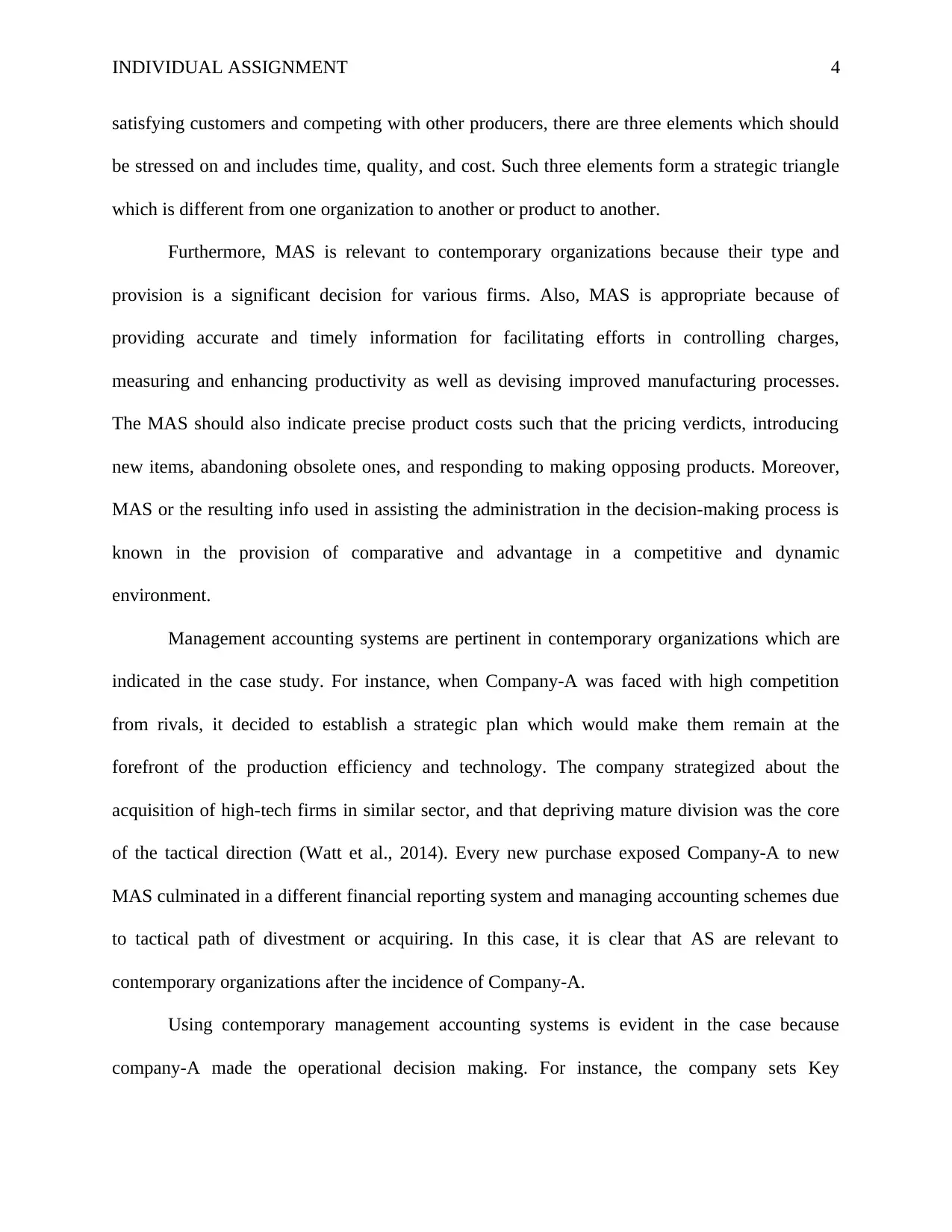
INDIVIDUAL ASSIGNMENT 4
satisfying customers and competing with other producers, there are three elements which should
be stressed on and includes time, quality, and cost. Such three elements form a strategic triangle
which is different from one organization to another or product to another.
Furthermore, MAS is relevant to contemporary organizations because their type and
provision is a significant decision for various firms. Also, MAS is appropriate because of
providing accurate and timely information for facilitating efforts in controlling charges,
measuring and enhancing productivity as well as devising improved manufacturing processes.
The MAS should also indicate precise product costs such that the pricing verdicts, introducing
new items, abandoning obsolete ones, and responding to making opposing products. Moreover,
MAS or the resulting info used in assisting the administration in the decision-making process is
known in the provision of comparative and advantage in a competitive and dynamic
environment.
Management accounting systems are pertinent in contemporary organizations which are
indicated in the case study. For instance, when Company-A was faced with high competition
from rivals, it decided to establish a strategic plan which would make them remain at the
forefront of the production efficiency and technology. The company strategized about the
acquisition of high-tech firms in similar sector, and that depriving mature division was the core
of the tactical direction (Watt et al., 2014). Every new purchase exposed Company-A to new
MAS culminated in a different financial reporting system and managing accounting schemes due
to tactical path of divestment or acquiring. In this case, it is clear that AS are relevant to
contemporary organizations after the incidence of Company-A.
Using contemporary management accounting systems is evident in the case because
company-A made the operational decision making. For instance, the company sets Key
satisfying customers and competing with other producers, there are three elements which should
be stressed on and includes time, quality, and cost. Such three elements form a strategic triangle
which is different from one organization to another or product to another.
Furthermore, MAS is relevant to contemporary organizations because their type and
provision is a significant decision for various firms. Also, MAS is appropriate because of
providing accurate and timely information for facilitating efforts in controlling charges,
measuring and enhancing productivity as well as devising improved manufacturing processes.
The MAS should also indicate precise product costs such that the pricing verdicts, introducing
new items, abandoning obsolete ones, and responding to making opposing products. Moreover,
MAS or the resulting info used in assisting the administration in the decision-making process is
known in the provision of comparative and advantage in a competitive and dynamic
environment.
Management accounting systems are pertinent in contemporary organizations which are
indicated in the case study. For instance, when Company-A was faced with high competition
from rivals, it decided to establish a strategic plan which would make them remain at the
forefront of the production efficiency and technology. The company strategized about the
acquisition of high-tech firms in similar sector, and that depriving mature division was the core
of the tactical direction (Watt et al., 2014). Every new purchase exposed Company-A to new
MAS culminated in a different financial reporting system and managing accounting schemes due
to tactical path of divestment or acquiring. In this case, it is clear that AS are relevant to
contemporary organizations after the incidence of Company-A.
Using contemporary management accounting systems is evident in the case because
company-A made the operational decision making. For instance, the company sets Key
Paraphrase This Document
Need a fresh take? Get an instant paraphrase of this document with our AI Paraphraser
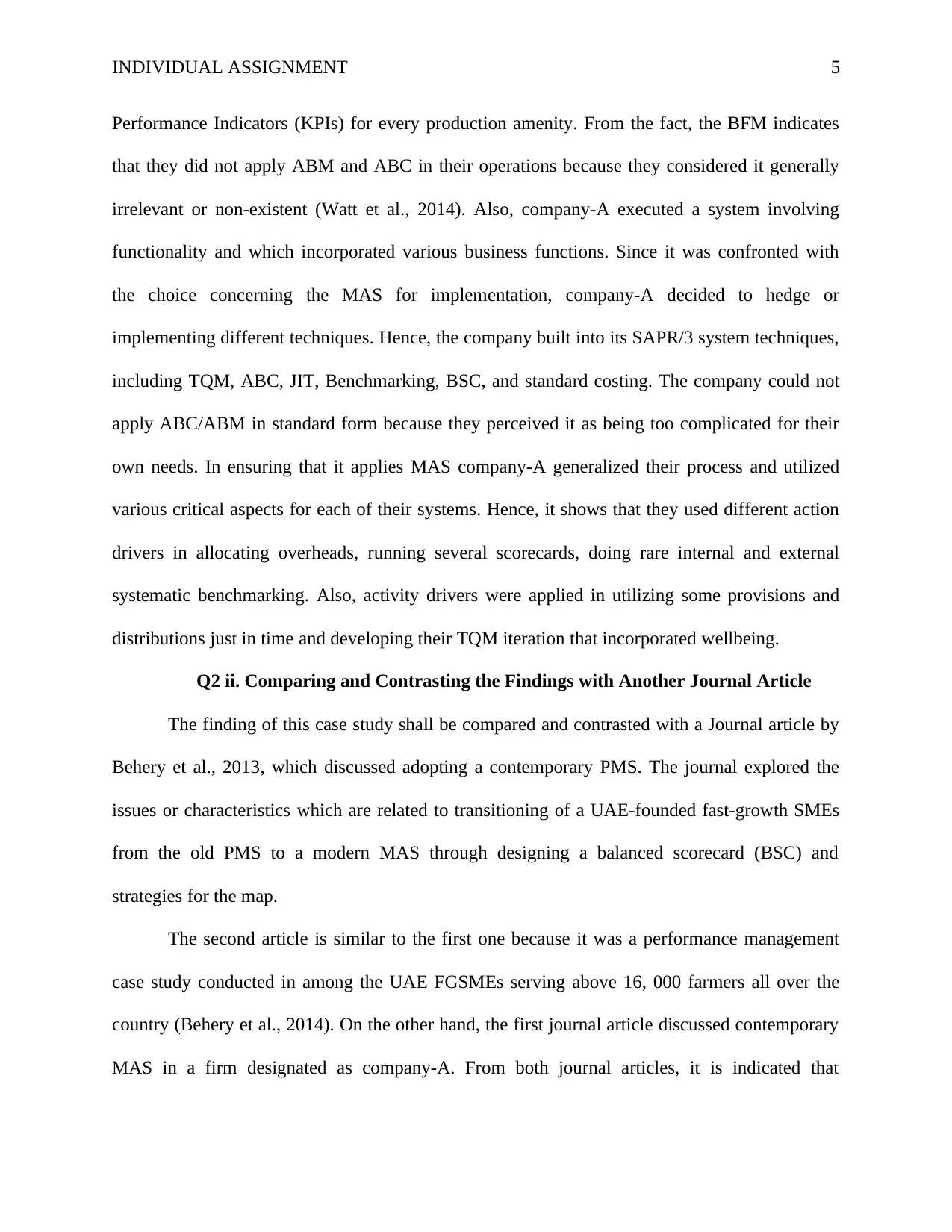
INDIVIDUAL ASSIGNMENT 5
Performance Indicators (KPIs) for every production amenity. From the fact, the BFM indicates
that they did not apply ABM and ABC in their operations because they considered it generally
irrelevant or non-existent (Watt et al., 2014). Also, company-A executed a system involving
functionality and which incorporated various business functions. Since it was confronted with
the choice concerning the MAS for implementation, company-A decided to hedge or
implementing different techniques. Hence, the company built into its SAPR/3 system techniques,
including TQM, ABC, JIT, Benchmarking, BSC, and standard costing. The company could not
apply ABC/ABM in standard form because they perceived it as being too complicated for their
own needs. In ensuring that it applies MAS company-A generalized their process and utilized
various critical aspects for each of their systems. Hence, it shows that they used different action
drivers in allocating overheads, running several scorecards, doing rare internal and external
systematic benchmarking. Also, activity drivers were applied in utilizing some provisions and
distributions just in time and developing their TQM iteration that incorporated wellbeing.
Q2 ii. Comparing and Contrasting the Findings with Another Journal Article
The finding of this case study shall be compared and contrasted with a Journal article by
Behery et al., 2013, which discussed adopting a contemporary PMS. The journal explored the
issues or characteristics which are related to transitioning of a UAE-founded fast-growth SMEs
from the old PMS to a modern MAS through designing a balanced scorecard (BSC) and
strategies for the map.
The second article is similar to the first one because it was a performance management
case study conducted in among the UAE FGSMEs serving above 16, 000 farmers all over the
country (Behery et al., 2014). On the other hand, the first journal article discussed contemporary
MAS in a firm designated as company-A. From both journal articles, it is indicated that
Performance Indicators (KPIs) for every production amenity. From the fact, the BFM indicates
that they did not apply ABM and ABC in their operations because they considered it generally
irrelevant or non-existent (Watt et al., 2014). Also, company-A executed a system involving
functionality and which incorporated various business functions. Since it was confronted with
the choice concerning the MAS for implementation, company-A decided to hedge or
implementing different techniques. Hence, the company built into its SAPR/3 system techniques,
including TQM, ABC, JIT, Benchmarking, BSC, and standard costing. The company could not
apply ABC/ABM in standard form because they perceived it as being too complicated for their
own needs. In ensuring that it applies MAS company-A generalized their process and utilized
various critical aspects for each of their systems. Hence, it shows that they used different action
drivers in allocating overheads, running several scorecards, doing rare internal and external
systematic benchmarking. Also, activity drivers were applied in utilizing some provisions and
distributions just in time and developing their TQM iteration that incorporated wellbeing.
Q2 ii. Comparing and Contrasting the Findings with Another Journal Article
The finding of this case study shall be compared and contrasted with a Journal article by
Behery et al., 2013, which discussed adopting a contemporary PMS. The journal explored the
issues or characteristics which are related to transitioning of a UAE-founded fast-growth SMEs
from the old PMS to a modern MAS through designing a balanced scorecard (BSC) and
strategies for the map.
The second article is similar to the first one because it was a performance management
case study conducted in among the UAE FGSMEs serving above 16, 000 farmers all over the
country (Behery et al., 2014). On the other hand, the first journal article discussed contemporary
MAS in a firm designated as company-A. From both journal articles, it is indicated that
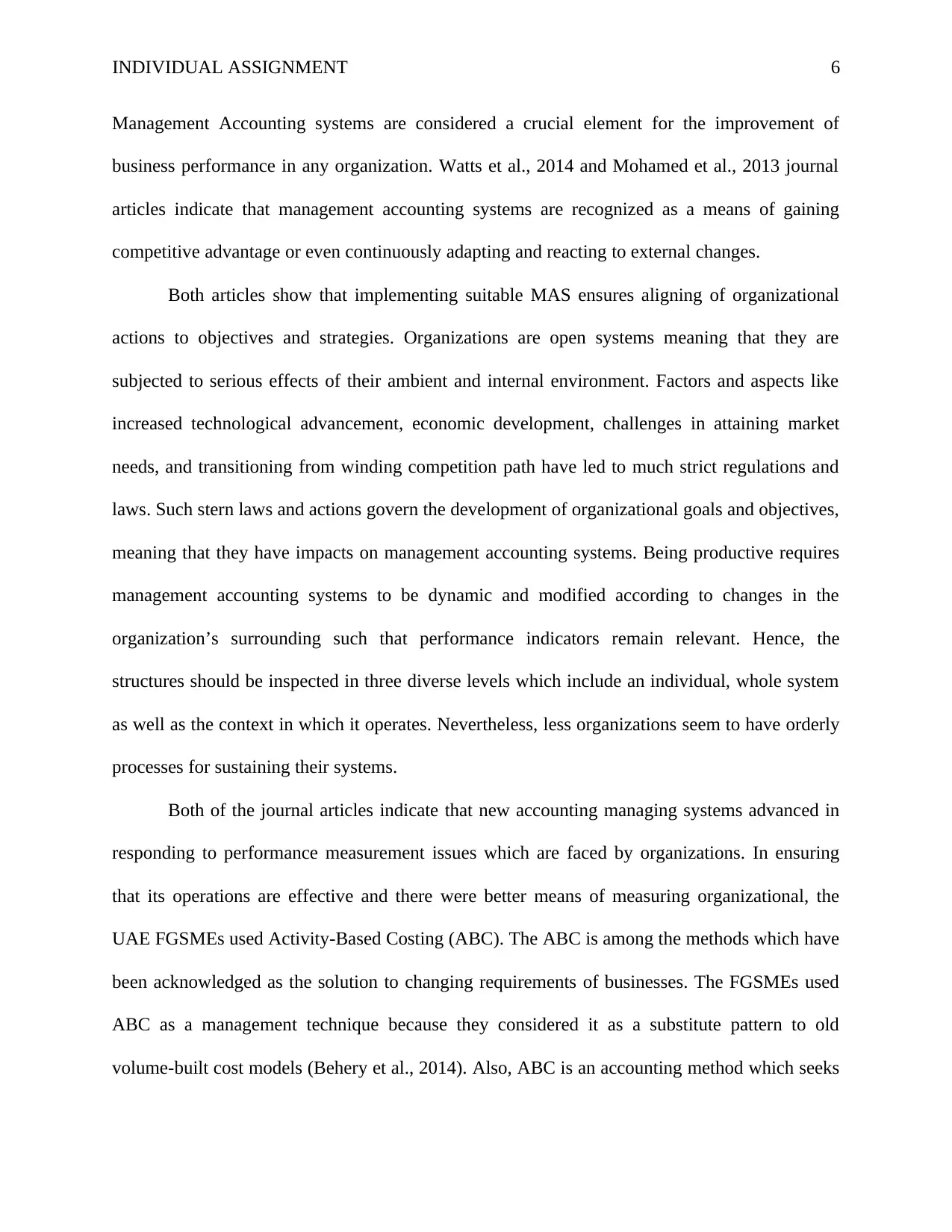
INDIVIDUAL ASSIGNMENT 6
Management Accounting systems are considered a crucial element for the improvement of
business performance in any organization. Watts et al., 2014 and Mohamed et al., 2013 journal
articles indicate that management accounting systems are recognized as a means of gaining
competitive advantage or even continuously adapting and reacting to external changes.
Both articles show that implementing suitable MAS ensures aligning of organizational
actions to objectives and strategies. Organizations are open systems meaning that they are
subjected to serious effects of their ambient and internal environment. Factors and aspects like
increased technological advancement, economic development, challenges in attaining market
needs, and transitioning from winding competition path have led to much strict regulations and
laws. Such stern laws and actions govern the development of organizational goals and objectives,
meaning that they have impacts on management accounting systems. Being productive requires
management accounting systems to be dynamic and modified according to changes in the
organization’s surrounding such that performance indicators remain relevant. Hence, the
structures should be inspected in three diverse levels which include an individual, whole system
as well as the context in which it operates. Nevertheless, less organizations seem to have orderly
processes for sustaining their systems.
Both of the journal articles indicate that new accounting managing systems advanced in
responding to performance measurement issues which are faced by organizations. In ensuring
that its operations are effective and there were better means of measuring organizational, the
UAE FGSMEs used Activity-Based Costing (ABC). The ABC is among the methods which have
been acknowledged as the solution to changing requirements of businesses. The FGSMEs used
ABC as a management technique because they considered it as a substitute pattern to old
volume-built cost models (Behery et al., 2014). Also, ABC is an accounting method which seeks
Management Accounting systems are considered a crucial element for the improvement of
business performance in any organization. Watts et al., 2014 and Mohamed et al., 2013 journal
articles indicate that management accounting systems are recognized as a means of gaining
competitive advantage or even continuously adapting and reacting to external changes.
Both articles show that implementing suitable MAS ensures aligning of organizational
actions to objectives and strategies. Organizations are open systems meaning that they are
subjected to serious effects of their ambient and internal environment. Factors and aspects like
increased technological advancement, economic development, challenges in attaining market
needs, and transitioning from winding competition path have led to much strict regulations and
laws. Such stern laws and actions govern the development of organizational goals and objectives,
meaning that they have impacts on management accounting systems. Being productive requires
management accounting systems to be dynamic and modified according to changes in the
organization’s surrounding such that performance indicators remain relevant. Hence, the
structures should be inspected in three diverse levels which include an individual, whole system
as well as the context in which it operates. Nevertheless, less organizations seem to have orderly
processes for sustaining their systems.
Both of the journal articles indicate that new accounting managing systems advanced in
responding to performance measurement issues which are faced by organizations. In ensuring
that its operations are effective and there were better means of measuring organizational, the
UAE FGSMEs used Activity-Based Costing (ABC). The ABC is among the methods which have
been acknowledged as the solution to changing requirements of businesses. The FGSMEs used
ABC as a management technique because they considered it as a substitute pattern to old
volume-built cost models (Behery et al., 2014). Also, ABC is an accounting method which seeks
⊘ This is a preview!⊘
Do you want full access?
Subscribe today to unlock all pages.

Trusted by 1+ million students worldwide
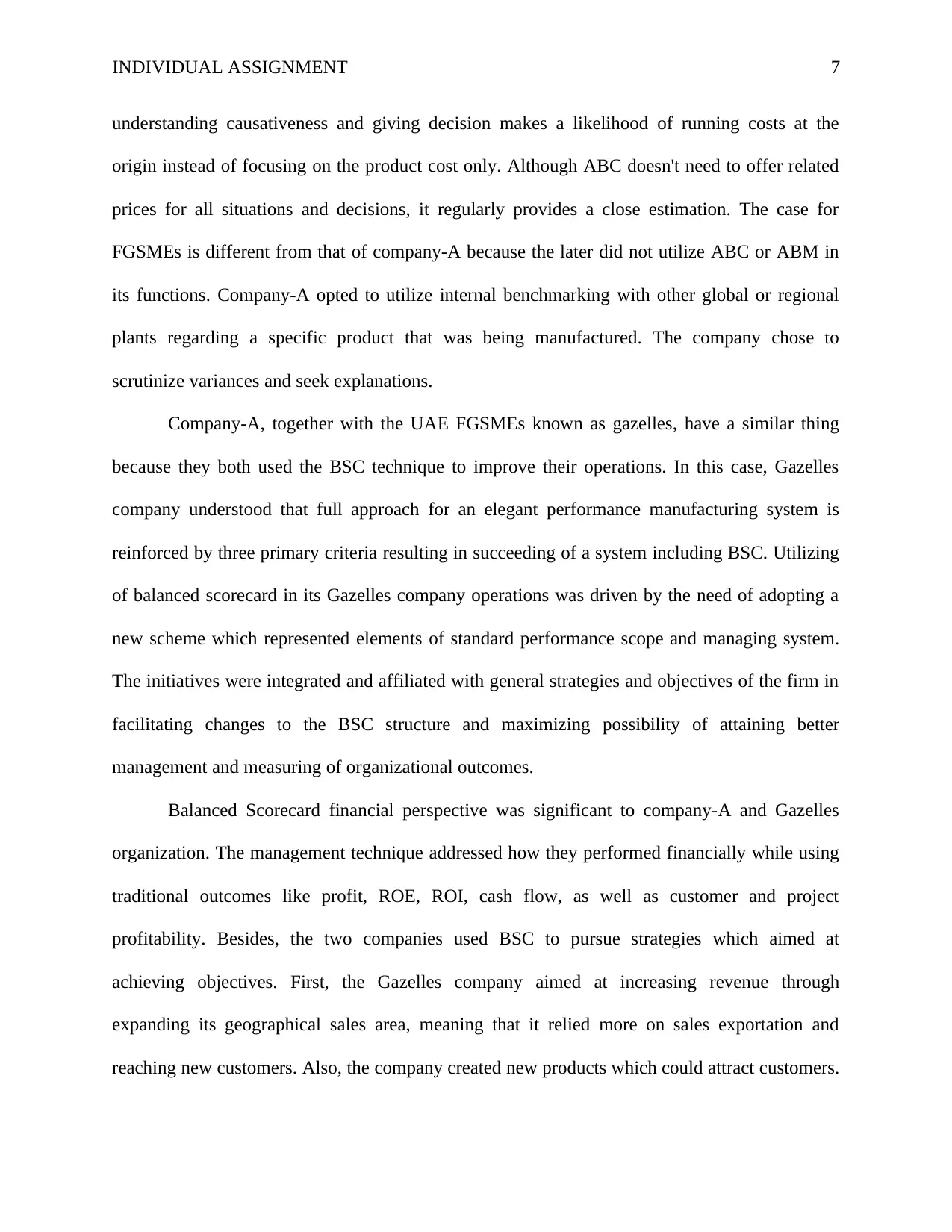
INDIVIDUAL ASSIGNMENT 7
understanding causativeness and giving decision makes a likelihood of running costs at the
origin instead of focusing on the product cost only. Although ABC doesn't need to offer related
prices for all situations and decisions, it regularly provides a close estimation. The case for
FGSMEs is different from that of company-A because the later did not utilize ABC or ABM in
its functions. Company-A opted to utilize internal benchmarking with other global or regional
plants regarding a specific product that was being manufactured. The company chose to
scrutinize variances and seek explanations.
Company-A, together with the UAE FGSMEs known as gazelles, have a similar thing
because they both used the BSC technique to improve their operations. In this case, Gazelles
company understood that full approach for an elegant performance manufacturing system is
reinforced by three primary criteria resulting in succeeding of a system including BSC. Utilizing
of balanced scorecard in its Gazelles company operations was driven by the need of adopting a
new scheme which represented elements of standard performance scope and managing system.
The initiatives were integrated and affiliated with general strategies and objectives of the firm in
facilitating changes to the BSC structure and maximizing possibility of attaining better
management and measuring of organizational outcomes.
Balanced Scorecard financial perspective was significant to company-A and Gazelles
organization. The management technique addressed how they performed financially while using
traditional outcomes like profit, ROE, ROI, cash flow, as well as customer and project
profitability. Besides, the two companies used BSC to pursue strategies which aimed at
achieving objectives. First, the Gazelles company aimed at increasing revenue through
expanding its geographical sales area, meaning that it relied more on sales exportation and
reaching new customers. Also, the company created new products which could attract customers.
understanding causativeness and giving decision makes a likelihood of running costs at the
origin instead of focusing on the product cost only. Although ABC doesn't need to offer related
prices for all situations and decisions, it regularly provides a close estimation. The case for
FGSMEs is different from that of company-A because the later did not utilize ABC or ABM in
its functions. Company-A opted to utilize internal benchmarking with other global or regional
plants regarding a specific product that was being manufactured. The company chose to
scrutinize variances and seek explanations.
Company-A, together with the UAE FGSMEs known as gazelles, have a similar thing
because they both used the BSC technique to improve their operations. In this case, Gazelles
company understood that full approach for an elegant performance manufacturing system is
reinforced by three primary criteria resulting in succeeding of a system including BSC. Utilizing
of balanced scorecard in its Gazelles company operations was driven by the need of adopting a
new scheme which represented elements of standard performance scope and managing system.
The initiatives were integrated and affiliated with general strategies and objectives of the firm in
facilitating changes to the BSC structure and maximizing possibility of attaining better
management and measuring of organizational outcomes.
Balanced Scorecard financial perspective was significant to company-A and Gazelles
organization. The management technique addressed how they performed financially while using
traditional outcomes like profit, ROE, ROI, cash flow, as well as customer and project
profitability. Besides, the two companies used BSC to pursue strategies which aimed at
achieving objectives. First, the Gazelles company aimed at increasing revenue through
expanding its geographical sales area, meaning that it relied more on sales exportation and
reaching new customers. Also, the company created new products which could attract customers.
Paraphrase This Document
Need a fresh take? Get an instant paraphrase of this document with our AI Paraphraser
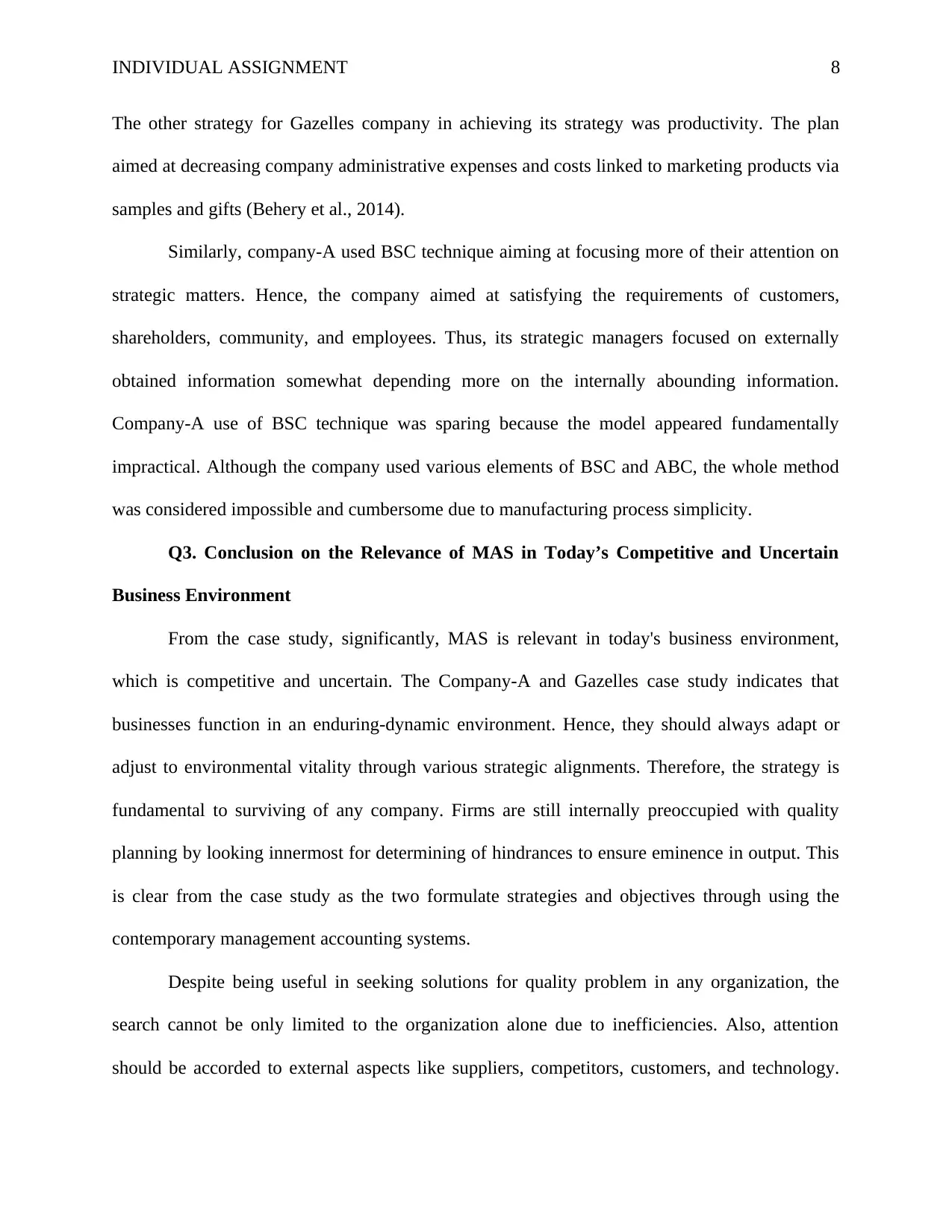
INDIVIDUAL ASSIGNMENT 8
The other strategy for Gazelles company in achieving its strategy was productivity. The plan
aimed at decreasing company administrative expenses and costs linked to marketing products via
samples and gifts (Behery et al., 2014).
Similarly, company-A used BSC technique aiming at focusing more of their attention on
strategic matters. Hence, the company aimed at satisfying the requirements of customers,
shareholders, community, and employees. Thus, its strategic managers focused on externally
obtained information somewhat depending more on the internally abounding information.
Company-A use of BSC technique was sparing because the model appeared fundamentally
impractical. Although the company used various elements of BSC and ABC, the whole method
was considered impossible and cumbersome due to manufacturing process simplicity.
Q3. Conclusion on the Relevance of MAS in Today’s Competitive and Uncertain
Business Environment
From the case study, significantly, MAS is relevant in today's business environment,
which is competitive and uncertain. The Company-A and Gazelles case study indicates that
businesses function in an enduring-dynamic environment. Hence, they should always adapt or
adjust to environmental vitality through various strategic alignments. Therefore, the strategy is
fundamental to surviving of any company. Firms are still internally preoccupied with quality
planning by looking innermost for determining of hindrances to ensure eminence in output. This
is clear from the case study as the two formulate strategies and objectives through using the
contemporary management accounting systems.
Despite being useful in seeking solutions for quality problem in any organization, the
search cannot be only limited to the organization alone due to inefficiencies. Also, attention
should be accorded to external aspects like suppliers, competitors, customers, and technology.
The other strategy for Gazelles company in achieving its strategy was productivity. The plan
aimed at decreasing company administrative expenses and costs linked to marketing products via
samples and gifts (Behery et al., 2014).
Similarly, company-A used BSC technique aiming at focusing more of their attention on
strategic matters. Hence, the company aimed at satisfying the requirements of customers,
shareholders, community, and employees. Thus, its strategic managers focused on externally
obtained information somewhat depending more on the internally abounding information.
Company-A use of BSC technique was sparing because the model appeared fundamentally
impractical. Although the company used various elements of BSC and ABC, the whole method
was considered impossible and cumbersome due to manufacturing process simplicity.
Q3. Conclusion on the Relevance of MAS in Today’s Competitive and Uncertain
Business Environment
From the case study, significantly, MAS is relevant in today's business environment,
which is competitive and uncertain. The Company-A and Gazelles case study indicates that
businesses function in an enduring-dynamic environment. Hence, they should always adapt or
adjust to environmental vitality through various strategic alignments. Therefore, the strategy is
fundamental to surviving of any company. Firms are still internally preoccupied with quality
planning by looking innermost for determining of hindrances to ensure eminence in output. This
is clear from the case study as the two formulate strategies and objectives through using the
contemporary management accounting systems.
Despite being useful in seeking solutions for quality problem in any organization, the
search cannot be only limited to the organization alone due to inefficiencies. Also, attention
should be accorded to external aspects like suppliers, competitors, customers, and technology.

INDIVIDUAL ASSIGNMENT 9
The above-listed factors are significant because they are conventionally considered by
administration in decision making or planning for an organization to deal with excellence issues.
From the case study, both company-A and Gazelles firm accorded attention to exterior elements,
including customers, opponents, and technology.
The case study of the two companies is a clear indication that the extent, and nature of
ecological uncertainty impacts quality objectives and management of firms. Adopting
management accounting systems and applying relevant techniques in their situation enabled
company-A and Gazelles to solve the challenges which they encountered. This led to company-A
using various methods, although it did not fully utilize a comprehensive contemporary MAS
(Watt et al., 2014). Combining the management levels utilization, category, and degree of the
operation or the prompts established in implementing provides a basis of suggesting that
company-A management accounting holds some relevance. However, the significance attached
by the management system for company-A is not at a strategic level. Gazelles FGSMEs also
utilized the importance of management accounting systems. Gazelles company used the balanced
scorecard to refine its strategy while ensuring its expression into operational terms.
Q4. Lessons Learned from The Two Articles Research Findings
The two articles have provided comprehensive knowledge concerning the application of
management accounting systems as well as the existing techniques. Since both cases have
applied different management accounting methods, they offer useful information and skills
where Australian management accountants can acquire comprehensive knowledge concerning
MAS.
The first lesson learned from the case studies is that contemporary MAS cannot develop
in seclusion of environmental variations. Hence, they should understand that the catalysts for
The above-listed factors are significant because they are conventionally considered by
administration in decision making or planning for an organization to deal with excellence issues.
From the case study, both company-A and Gazelles firm accorded attention to exterior elements,
including customers, opponents, and technology.
The case study of the two companies is a clear indication that the extent, and nature of
ecological uncertainty impacts quality objectives and management of firms. Adopting
management accounting systems and applying relevant techniques in their situation enabled
company-A and Gazelles to solve the challenges which they encountered. This led to company-A
using various methods, although it did not fully utilize a comprehensive contemporary MAS
(Watt et al., 2014). Combining the management levels utilization, category, and degree of the
operation or the prompts established in implementing provides a basis of suggesting that
company-A management accounting holds some relevance. However, the significance attached
by the management system for company-A is not at a strategic level. Gazelles FGSMEs also
utilized the importance of management accounting systems. Gazelles company used the balanced
scorecard to refine its strategy while ensuring its expression into operational terms.
Q4. Lessons Learned from The Two Articles Research Findings
The two articles have provided comprehensive knowledge concerning the application of
management accounting systems as well as the existing techniques. Since both cases have
applied different management accounting methods, they offer useful information and skills
where Australian management accountants can acquire comprehensive knowledge concerning
MAS.
The first lesson learned from the case studies is that contemporary MAS cannot develop
in seclusion of environmental variations. Hence, they should understand that the catalysts for
⊘ This is a preview!⊘
Do you want full access?
Subscribe today to unlock all pages.

Trusted by 1+ million students worldwide
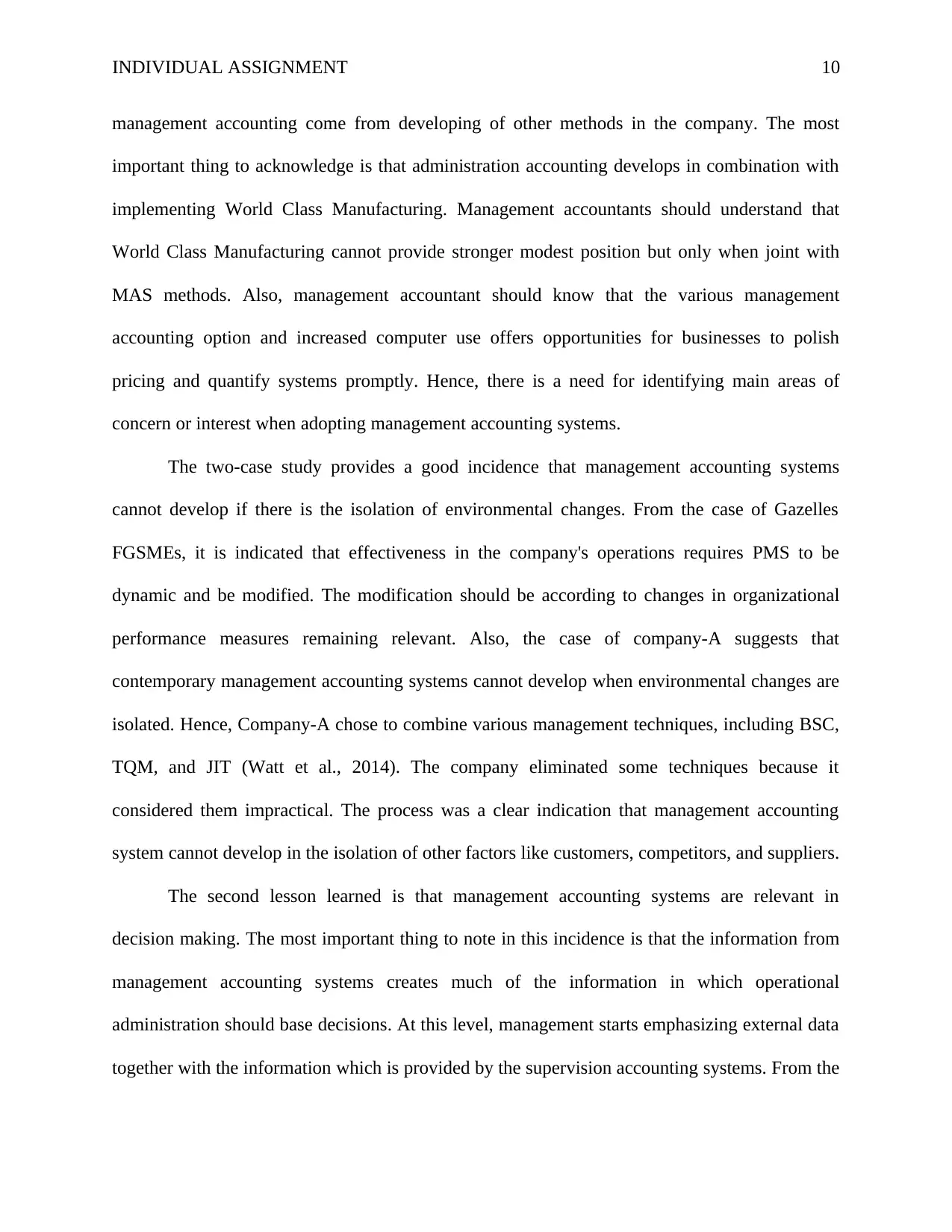
INDIVIDUAL ASSIGNMENT 10
management accounting come from developing of other methods in the company. The most
important thing to acknowledge is that administration accounting develops in combination with
implementing World Class Manufacturing. Management accountants should understand that
World Class Manufacturing cannot provide stronger modest position but only when joint with
MAS methods. Also, management accountant should know that the various management
accounting option and increased computer use offers opportunities for businesses to polish
pricing and quantify systems promptly. Hence, there is a need for identifying main areas of
concern or interest when adopting management accounting systems.
The two-case study provides a good incidence that management accounting systems
cannot develop if there is the isolation of environmental changes. From the case of Gazelles
FGSMEs, it is indicated that effectiveness in the company's operations requires PMS to be
dynamic and be modified. The modification should be according to changes in organizational
performance measures remaining relevant. Also, the case of company-A suggests that
contemporary management accounting systems cannot develop when environmental changes are
isolated. Hence, Company-A chose to combine various management techniques, including BSC,
TQM, and JIT (Watt et al., 2014). The company eliminated some techniques because it
considered them impractical. The process was a clear indication that management accounting
system cannot develop in the isolation of other factors like customers, competitors, and suppliers.
The second lesson learned is that management accounting systems are relevant in
decision making. The most important thing to note in this incidence is that the information from
management accounting systems creates much of the information in which operational
administration should base decisions. At this level, management starts emphasizing external data
together with the information which is provided by the supervision accounting systems. From the
management accounting come from developing of other methods in the company. The most
important thing to acknowledge is that administration accounting develops in combination with
implementing World Class Manufacturing. Management accountants should understand that
World Class Manufacturing cannot provide stronger modest position but only when joint with
MAS methods. Also, management accountant should know that the various management
accounting option and increased computer use offers opportunities for businesses to polish
pricing and quantify systems promptly. Hence, there is a need for identifying main areas of
concern or interest when adopting management accounting systems.
The two-case study provides a good incidence that management accounting systems
cannot develop if there is the isolation of environmental changes. From the case of Gazelles
FGSMEs, it is indicated that effectiveness in the company's operations requires PMS to be
dynamic and be modified. The modification should be according to changes in organizational
performance measures remaining relevant. Also, the case of company-A suggests that
contemporary management accounting systems cannot develop when environmental changes are
isolated. Hence, Company-A chose to combine various management techniques, including BSC,
TQM, and JIT (Watt et al., 2014). The company eliminated some techniques because it
considered them impractical. The process was a clear indication that management accounting
system cannot develop in the isolation of other factors like customers, competitors, and suppliers.
The second lesson learned is that management accounting systems are relevant in
decision making. The most important thing to note in this incidence is that the information from
management accounting systems creates much of the information in which operational
administration should base decisions. At this level, management starts emphasizing external data
together with the information which is provided by the supervision accounting systems. From the
Paraphrase This Document
Need a fresh take? Get an instant paraphrase of this document with our AI Paraphraser

INDIVIDUAL ASSIGNMENT 11
case study, it is shown that strategic managers encounter demands from various shareholders
relying on outward evidence. In company-A, internal administration accounting is relatively
inconsequential and used in obtaining financial reports. In this case, the managers perceive the
MAS as lacking any relevance. The incidence is a clear indication that management accounting
systems are relevant in decision making. For instance, it is only the tactical and operational
decisions which could ensure that the operations and activities of Company are proper.
The third lesson learned is from Company-A and shows that it is significant in identifying
business problem areas and using the right management accounting system technique in handling
such challenges. Company-A used various management accounting techniques when compared
to Gazelles FGSMEs. The management accounting which company-A adopted revealed different
challenging results. The company had several management accounting techniques like TQM,
ABC, JIT, and BSC, although there is none of them which was utilized as initially prescribed.
For instance, ABC was banned as an effective technique in spite of academic rhetoric about
ABC's manufacturer's appropriateness. Likewise, BSC was sparingly used, making it appear
fundamentally impractical. For instance, in the company-A situation, each MAS method seems
to have had selected elements for the use which left most methods unimplemented or not used.
Regarding the case study, the critical thing was acquiring several contemporary
management accounting techniques. Hence, the users could utilize whichever MAS method was
believed as being convenient in their desires. The challenge arising from the Company-A was a
failure of the static managers to rarely work on evidence which was coming from management
accounting systems. Therefore, the lesson learned here is that management accounting systems
are essential in the identification of challenges and should be relied upon for proper operations
and functioning of any organization.
case study, it is shown that strategic managers encounter demands from various shareholders
relying on outward evidence. In company-A, internal administration accounting is relatively
inconsequential and used in obtaining financial reports. In this case, the managers perceive the
MAS as lacking any relevance. The incidence is a clear indication that management accounting
systems are relevant in decision making. For instance, it is only the tactical and operational
decisions which could ensure that the operations and activities of Company are proper.
The third lesson learned is from Company-A and shows that it is significant in identifying
business problem areas and using the right management accounting system technique in handling
such challenges. Company-A used various management accounting techniques when compared
to Gazelles FGSMEs. The management accounting which company-A adopted revealed different
challenging results. The company had several management accounting techniques like TQM,
ABC, JIT, and BSC, although there is none of them which was utilized as initially prescribed.
For instance, ABC was banned as an effective technique in spite of academic rhetoric about
ABC's manufacturer's appropriateness. Likewise, BSC was sparingly used, making it appear
fundamentally impractical. For instance, in the company-A situation, each MAS method seems
to have had selected elements for the use which left most methods unimplemented or not used.
Regarding the case study, the critical thing was acquiring several contemporary
management accounting techniques. Hence, the users could utilize whichever MAS method was
believed as being convenient in their desires. The challenge arising from the Company-A was a
failure of the static managers to rarely work on evidence which was coming from management
accounting systems. Therefore, the lesson learned here is that management accounting systems
are essential in the identification of challenges and should be relied upon for proper operations
and functioning of any organization.
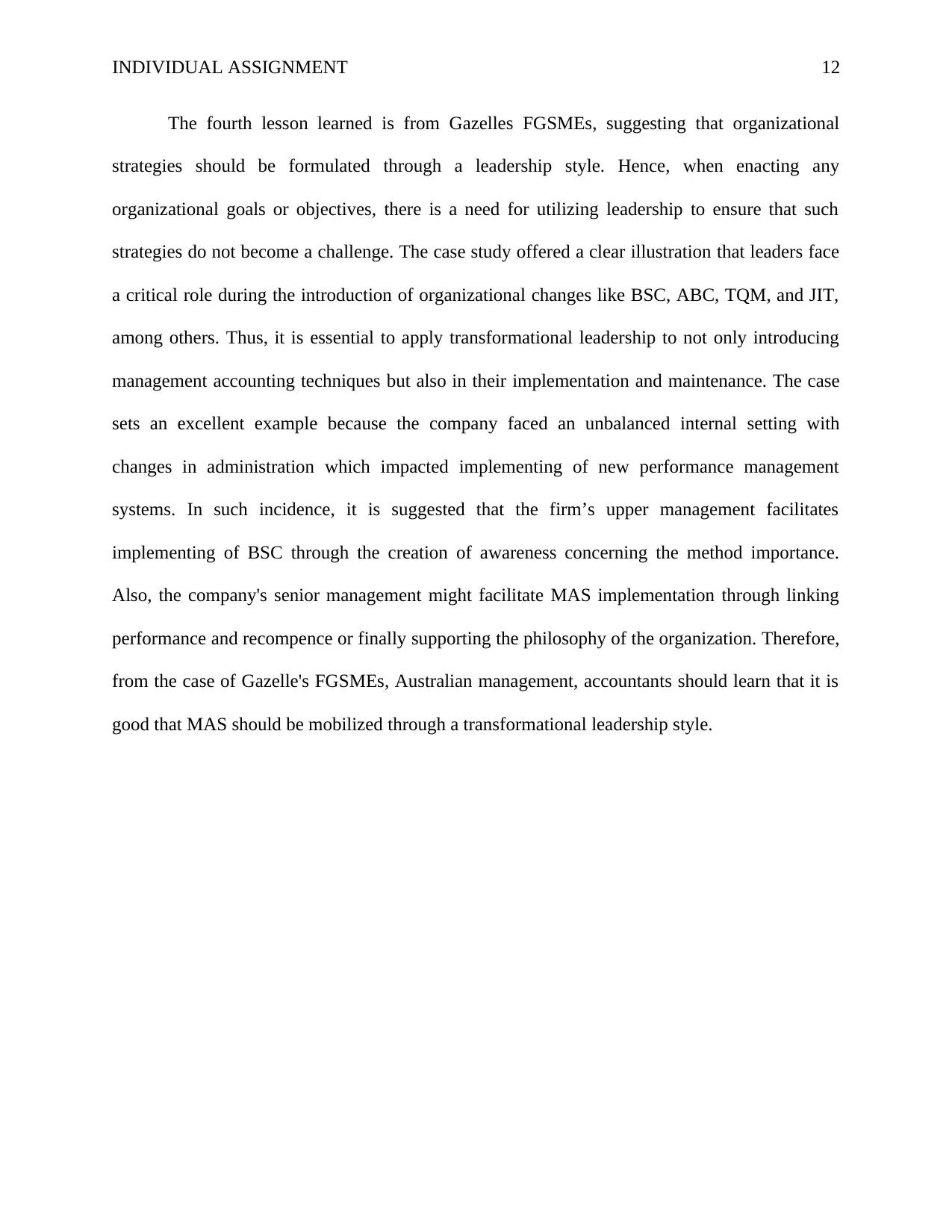
INDIVIDUAL ASSIGNMENT 12
The fourth lesson learned is from Gazelles FGSMEs, suggesting that organizational
strategies should be formulated through a leadership style. Hence, when enacting any
organizational goals or objectives, there is a need for utilizing leadership to ensure that such
strategies do not become a challenge. The case study offered a clear illustration that leaders face
a critical role during the introduction of organizational changes like BSC, ABC, TQM, and JIT,
among others. Thus, it is essential to apply transformational leadership to not only introducing
management accounting techniques but also in their implementation and maintenance. The case
sets an excellent example because the company faced an unbalanced internal setting with
changes in administration which impacted implementing of new performance management
systems. In such incidence, it is suggested that the firm’s upper management facilitates
implementing of BSC through the creation of awareness concerning the method importance.
Also, the company's senior management might facilitate MAS implementation through linking
performance and recompence or finally supporting the philosophy of the organization. Therefore,
from the case of Gazelle's FGSMEs, Australian management, accountants should learn that it is
good that MAS should be mobilized through a transformational leadership style.
The fourth lesson learned is from Gazelles FGSMEs, suggesting that organizational
strategies should be formulated through a leadership style. Hence, when enacting any
organizational goals or objectives, there is a need for utilizing leadership to ensure that such
strategies do not become a challenge. The case study offered a clear illustration that leaders face
a critical role during the introduction of organizational changes like BSC, ABC, TQM, and JIT,
among others. Thus, it is essential to apply transformational leadership to not only introducing
management accounting techniques but also in their implementation and maintenance. The case
sets an excellent example because the company faced an unbalanced internal setting with
changes in administration which impacted implementing of new performance management
systems. In such incidence, it is suggested that the firm’s upper management facilitates
implementing of BSC through the creation of awareness concerning the method importance.
Also, the company's senior management might facilitate MAS implementation through linking
performance and recompence or finally supporting the philosophy of the organization. Therefore,
from the case of Gazelle's FGSMEs, Australian management, accountants should learn that it is
good that MAS should be mobilized through a transformational leadership style.
⊘ This is a preview!⊘
Do you want full access?
Subscribe today to unlock all pages.

Trusted by 1+ million students worldwide
1 out of 13
Related Documents
Your All-in-One AI-Powered Toolkit for Academic Success.
+13062052269
info@desklib.com
Available 24*7 on WhatsApp / Email
![[object Object]](/_next/static/media/star-bottom.7253800d.svg)
Unlock your academic potential
Copyright © 2020–2025 A2Z Services. All Rights Reserved. Developed and managed by ZUCOL.





